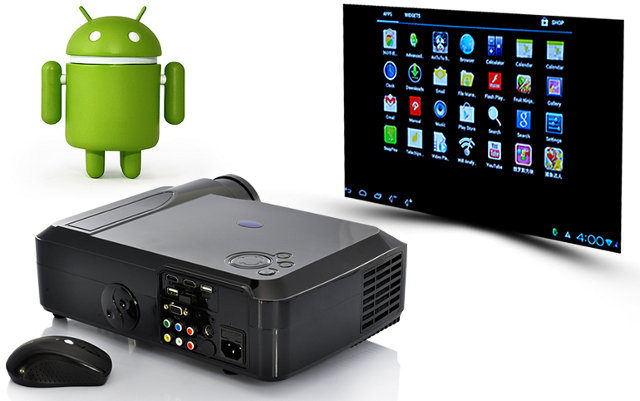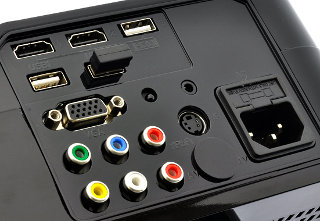Android is now everywhere, from the ubiquitous smartphones and tablets to cars, cameras, satellites (no kidding), light bulbs (seriously) and more. Today is the first time I’ve come across a full sized projector running Android. The “Smartbeam” is a 2000 lumens 1280×768 (native) projector powered by Telechips TCC8925 with 512 MB RAM and 4 GB Flash running Android 4.0.4 (ICS), so the performance should be very similar to CX-01 mini PC.
 Here are the specs of this new device:
Here are the specs of this new device:
- SoC – Telechips TCC8925 up to 833 MHz
- System Memory – 512 MB RAM
- Storage – 4 GB NAND Flash
- WiFi – 802.11 b/g/n
- Display – 5.8″ Single LCD Panel Display Technology (cnxsoft: But I can’t find any display on any of the pictures…)
- Projector:
- Projection Lens – Manual Lens
- Resolution: Native SGA (1280*768 Pixels), Support Resolution QGA (1920 x 1200)
- Brightness (Typical) – LED lamp 2000 lumens, more than 320Lux
- Lamp Life – Estimated life of over 20,000 hours
- Contrast Ratio – 1000:1 (Full On / Full Off)
- Throw Ratio – 100″ at 3.5m
- Projection Distance – 1.5m to 8m
- Image Size (Diagonal) – 50” to 180”
- 3D Projection Support – Red and Blue / Red and Green
- Projection Method – Front, Rear, Ceiling Mount, Table Top
- Horizontal Scan Rate – 15, 30 – 91.4 KHz
- Vertical Refresh Rate – 43 – 87 Hz
- Keystone Correction – ± 15° Vertical
 External Connectors:
External Connectors:
- 2x HDMI
- 3x USB Host Ports
- PS/2 Port
- VGA
- Composite (RCA)
- Component (YPbPr )
- S-Video
- 3.5mm audio jack
- Video files – 1080P video playback, AVI, MOV, TS, M2TS, RM/RMVB, FLV, WMV & 3GP
- Audio files – MP3, WMA, WAV, OGG, FLAC, APE & AAC
- Operating Temperature – 5 to 40°C, 85% Max Humidity
- Power Supply – AC Input 100-240V, 50-60Hz, Auto-Switching, DC 15V at 3A
- Power Consumption – 90 W, <1 Watt in standby mode
The project is sold with a wireless mouse, VGA/AV and power cables, an IR remote control, and a user manual. Since the solution is based on Telechips TCC8925, it’s likely it will be hackable (i.e. custom ROMs), but you’ll probably won’t be able to run Linux on it.
Chinavasion has a promotion video showing the device in action, and how it will make your girl (and her friends) have what looks like the best time of their life… I’m very surprised by the clarity of the image, and I suppose it won’t be as sharp and clear in actual use.
Smartbeam multimedia projector sells for $422 on Chinavasion, but I initially discovered the products on Dealextreme for $538 sold as model EPW5801AA1, which looks exactly the same, except the lamp life is claimed to be 50,000 hours (Yeah right…). However, Dealextreme does not list the processor and RAM for the device, so it could be a different solution with a similar casing.

Jean-Luc started CNX Software in 2010 as a part-time endeavor, before quitting his job as a software engineering manager, and starting to write daily news, and reviews full time later in 2011.
Support CNX Software! Donate via cryptocurrencies, become a Patron on Patreon, or purchase goods on Amazon or Aliexpress






OH BOY!! I can’t WAIT to brick a projector
833 MHz slow decoding MKV and iso file
@Alexandr
I used to play 1080p 40 Mbps H.264 videos on a 300 MHz MIPS media processor, so the processor frequency should not really affect video playback on SoCs with an hardware video decoder. If you do have issues, it could be because of software rendering. Using a player such as diceplayer could improve playback a lot.
@lex
LOL :p I think this says it all. Don’t newer projectors come with HMDI ports? Just plug in an android stick and away you go, with no fear of bricking the projector, and a way to upgrade to better processors, newer Android versions etc just by buying a new stick…
The only thing really interesting with a projector is how it projects 😉 All else is secondary. Colors, contrast, intensity under not so ideal conditions. I mean, it’s dead cheap.
Anyone play with one yet.
cnxsoft wrote, referring to the “5.8 inch LCD display”: “…I can’t find any display on any of the pictures…” I think the “display” referenced is the one between the light source and the lens 🙂 Many cheaper projectors now use a single LCD panel instead of a DLP chip.